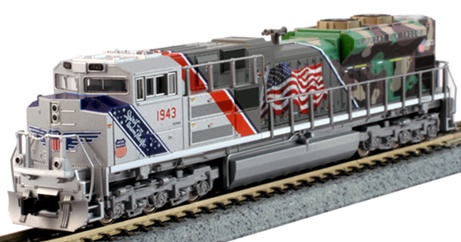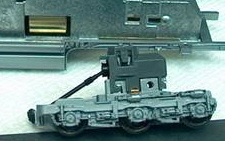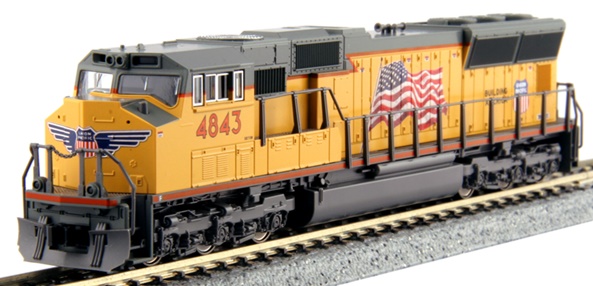SD70MAC -


SD70M -


SD70MAC -


SD70M -




Introduced: 2003 (SD70MAC), 2005 (SD70M), 2006 (Flat Radiator SD70M), 2009 (SD70ACe and revised SD70M), 2016 (DCC-Equipped SD70ACe), 2017 (DCC-Equipped SD70M), 2018 (DCC-Equipped SD70MAC, Nose Headlight SD70ACe), 2020 (Phase 2 SD70M), 2021 (DCC Sound SD70M's), 2023 (DCC Sound SD70ACe's) and 2024 (DCC Sound SD70MAC)
Although these models employ two distinctly different mechanisms, they're all wrungs on the same evolutionary ladder. So, to save myself a bit of time I'm going to cover them all here. Kato's SD70ACe and post-2009 SD70M models employ a "screwless" chassis/mechanism, whereas the SD70MAC and pre-2009 SD70M's employ the same "screwed together" chassis/mechanism used on Kato's GE C44-9W, AC4400CW and ES44AC models -

This pre-2009 mechanism models employ all of time-honored design features one normally associates with "modern" Kato diesels - shell-mounted couplers, split-frame DCC-Ready metal chassis, dual-flywheels, low-friction drive, plastic truck assemblies, plastic gearing, blackened wheels, all-wheel drive, and all-wheel pick-up (no traction tires). The motor is an open-sided 5-poler. Directional lighting is provided by a PC board mounted on top of the chassis (in the above-right picture, I've swapped out the stock lightboard for a Digitrax decoder). The couplers are Kato's proprietary "semi-automatic" knuckle couplers. Wheels are low-profile and have no problems on Code-55 track.
These were the first Kato diesels to come with separately applied (as opposed to molded-in) MU hose details. On the downside, they (along with the numberboards and some of the handrails) are supplied ala carte and must be installed by the modeler.
Performance is virtually perfect - smooth, quiet, flawless pickup and throttle response, exceptional pulling power, etc. On the downside, they are pretty much limited to 11"-radius curves and broader (anything sharper than that and the wheels are derailing).
Here's what Kato has to say about them:
All of these models feature Kato's popular White LED Headlight, magnetic knuckle couplers, printed and lighted number boards, MU hose detail, a powerful five-pole motor with dual brass flywheels, and a DCC-friendly mechanism. Additionally, the models feature walkway-mounted, lighted ditch lights! Handrails are made of a paintable material so modelers can easily add white end railings. Two different headlight versions are available - one with the headlight in the cab and one with the headlight in the nose. These models are equipped with all-wheel electrical pick-up and blackened metal wheels in trucks that replicate the HTCR Phase II trucks. (On the prototype, this truck evolved from the HT-C trucks found on the SD40-2 through SD60 and features radial steering capability).
As noted above, the 2009 SD70ACe introduced an all-new chassis/mechanism into the line (also used on the 2009-and-forward SD70M's). Said new chassis employs the "screwless assembly" design introduced with Kato's 2007 "mid-production" SD40-2 model -

The mechanism sports all of the features of the original design (vis'a'vis the motor and the rest of the moving parts). Additionally, these models employ Kato's so-called "shock absorber construction" feature. The brass strips that conduct current from the trucks to the chassis used to be free-floating (free to spring up) on previous Kato models. Under the "shock absorber" system, they run the entire length of the chassis and are held firmly in place by plastic extensions coming off the fuel tank. This provides firm (IE, sprung) downward pressure on the truck contacts, with the net result being a quieter ride. In a similar vein, the center axle of each truck is sprung (with downward pressure provided by the needlepoint pickups in the wheels) -

The major difference between these new "screwless" models and previous models (at least as far as what the average dude needs to worry about) is the fact that the driveshafts run directly into the truck assemblies. And, for better or worse, said trucks dislodge from the chassis much more easily than did the trucks on the old "screwed together" diesels. The upshot of all that is that you have to be careful not to accidentally pull the trucks off. And if you do accidentally pull the trucks off, keep a watchful eye out for flying driveshafts and other fiddly bits that may be intent on "going missing".

I've read various accounts from folks who've received their SD70's with one (or both) of the trucks already partially (or fully) discombobulated - right inside the box. So, I'm not entirely sure what advancement has been achieved here. Speculation is that the old trucks were simply too difficult to pull from the chassis (resulting in a lot of damaged trucks). So, I dunno... pick yer poison I guess?
Another possible QC issue to be aware of with this second version relates to the metal contacts that transfer current from the lightboard to the motor. Said contacts are clipped to the lightboard (as opposed to soldered to it). And if said clips are loose (or misaligned), your loco ain't going to be moving too far. Not a big deal to fix though.
QC issues aside, performance on these models is sensational - smooth, quiet and responsive at all throttle levels, great slow speed creep, perfect pickup (no stalls over turnouts), strong pulling power, and overall just superb runners. Versions equipped with preinstalled TCS DCC decoders were released starting in 2016 (at first as part of Kato's Kobo Customs line and later on as part of their standard line). Versions equipped with ESU LokSound decoders were released starting in 2021 (and once again, Kobo Customs at first, then part of the standard line later on).
Kato released new "Phase 2" versions of the SD70M in 2020 (in both flat and flared radiator configurations). The truck sideframes are different (as compared to previous models), which I guess is what differentiates them from "Phase 1" SD70M's -

Prototype information -
The SD70ACe is the latest in the line of EMD's "70" locomotives, an evolution of the SD70MAC, although its radiator design harkens more to that of the SD80/90 body. The SD70ACe has been designed to fit the latest EPA standards and regulations, and sports 4300 horsepower. The Union Pacific has currently put in the largest purchase order for these units, and as a display of respect for the railroads it has incorporated, has produced six "Heritage" style painted locomotives with road numbers designated by the year they were merged into the UP.
Features -
- Heritage units will be specially painted with their unique paint schemes to honor their respective railroads
- Newly designed prototype-accurate bolsterless non-radial HTSC truck and five chime airhorn
- Exceptional and crisp molding to accentuate the distinct angular lines of the nose and high dynamic brake
- Powerful five-pole KATO motor with dual brass flywheels
- Directional Headlight and illuminated, preprinted numberboards
- Illuminated ditch lights
- Kato magnetic knuckle coupler
- DCC Friendly mechanism ready for drop-in decoder installation
Shell removal is dead simple - just grab the shell with one hand, the fuel tank with the other hand, and pull up. But once again, be careful not to dislodge the trucks.
Grade: A (for all)
SD70MAC reviewed: 06/03 Model Railroader ("Kato has released a highly detailed and smooth running SD70MAC. It has a dual flywheel mechanism and six-wheel radial trucks... Kato's SD70MAC closely matches the prototype... Our sample came ready to run with a couple of sprues containing the number boards, front grab irons, and rear MU cables... The body shell is made up of 13 interlocking pieces. Most of these parts are molded in color. The body shell is smoothly painted with sharply printed lettering... The SD70MAC's running gear is a stretched version of Kato's split-frame design... The scale 45"-diameter nickel-silver drivers and wheelsets match NMRA standards... Our sample SD70MAC performed smoothly, but seemed a little stiff at first. It started and ran steadily on 2 volts at 6.8 scale mph... The model's drawbar pull is equivalent to 24 cars... The model ran smoothly on a tight 9" minimum radius, but it looks much better on 11: or larger radii where the overhang is reduced. Kato knuckle couplers are mounted at the correct height in boxes attached with clips at each end... This model certainly lives up to Kato's reputation for detail and performance. I'm sure modelers of contemporary railroading will enjoy these heavy-duty diesel locomotives. BNSF, Conrail, CSX, Undec. $105.00")
SD70ACe eviewed 10/09 Model Railroader ("If you live near a Union Pacific main line, you may have seen the prototype for this Kato N scale diesel-electric locomotive. The Kato SD70ACe diesel offers plenty of prototypical detail and reliable performance. There are also drop-in Digital Command Control (DCC) decoders available for the model.
"The Kato model is made primarily of plastic. All the molded details, including the placement of access panel doors and grills, match prototype photos. The roof-mounted radiator fans are especially well done, with fan blades visible under the grills. All the handrails are gray flexible acetal plastic. Other separately applied details include the global-positioning-satellite dome on the cab roof and the roof-mounted five-chime air horn correctly located in the middle of the hood. The rear m.u. hoses are separate black plastic parts, but those on the front pilot are molded in gray as part of the snowplow.
"I easily removed the model's press-fit body shell using a toothpick to help separate it from the split die-cast metal frame. Housed inside the split frame are the can motor and dual brass flywheels. Universal shafts transfer power to truck-mounted gearboxes. All six of the model's axles are powered, giving the N scale diesel an impressive drawbar pull of 1.3 ounces. None of the locomotive's metal wheels have traction tires. The printed-circuit (PC) board is mounted on top of the split frame. White light-emitting diodes are at each end of the PC board. Plastic tubes in the body shell pipe light from the LEDs to the headlights and ditch lights.
"We tested the model in DC using a Model Rectifier Corp. Tech 4 power pack. The model's mechanism is very smooth and quiet throughout its speed range. It looked great rounding the 15" curves and performed smoothly through turnouts and crossovers. It crept along at less than 1 scale mph and accelerated to 121 scale mph at 12 volts. This is faster than a prototype SD70ACe, which has a top speed of about 75 mph.
"Whether on a DC or DCC layout, a pair of these smooth-performing contemporary mainline diesels would look great hauling an intermodal or unit coal train along an N scale layout. $110"